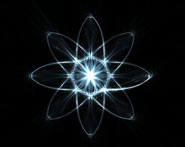


 الفيزياء الكلاسيكية
الفيزياء الكلاسيكية
 الكهربائية والمغناطيسية
الكهربائية والمغناطيسية
 علم البصريات
علم البصريات
 الفيزياء الحديثة
الفيزياء الحديثة
 النظرية النسبية
النظرية النسبية
 الفيزياء النووية
الفيزياء النووية
 فيزياء الحالة الصلبة
فيزياء الحالة الصلبة
 الليزر
الليزر
 علم الفلك
علم الفلك
 المجموعة الشمسية
المجموعة الشمسية
 الطاقة البديلة
الطاقة البديلة
 الفيزياء والعلوم الأخرى
الفيزياء والعلوم الأخرى
 مواضيع عامة في الفيزياء
مواضيع عامة في الفيزياء|
Read More
Date: 2-3-2016
Date: 23-8-2020
Date: 3-9-2020
|
Blackbody Characteristics
Blackbodies thus have three characteristics:
1 - A blackbody with a temperature higher than absolute zero emits some energy at all wavelengths.
2 - A blackbody at higher temperature emits more energy at all wavelengths than does a cooler one.
3 - The higher the temperature, the shorter the wavelength at which the maximum energy is emitted.
To illustrate, at a low temperature setting, a burner on an electric stove emits infrared radiation, which is transferred to other objects (such as pots and food) as heat. At a higher temperature, it also emits red light (lower frequency end of visible light range). If the electrical circuit could deliver enough energy, as the temperature increased further, the burner would turn yellow, or even blue-white.
The sun and other stars may, for most purposes, be considered blackbodies. So we can estimate temperatures of these objects based on the frequencies of radiation they emit in other words, according to their electromagnetic spectra.
For radiation produced by thermal mechanisms, the following table gives samples of wavelength ranges, the temperatures of the matter emitting in that range, and some example sources of such thermal radiation.

The hotter the object, the shorter is the wavelength of the radiation it emits. Actually, at hotter temperatures, more energy is emitted at all wavelengths. But the peak amount of energy is radiated at shorter wavelengths for higher temperatures. This relationship is known as Wien’s Law.
A beam of electromagnetic radiation can be regarded as a stream of tiny packets of energy called photons. Planck’s Law states that the energy carried by a photon is directly proportional to its frequency. To arrive at the exact energy value, the frequency is multiplied by Planck’s Constant, which has been found experimentally to be 6.625 x 10-27 erg sec. (The erg is a unit of energy) .
If we sum up the contributions from all parts of the electromagnetic spectrum, we obtain the total energy emitted by a blackbody over all wavelengths. That total energy, emitted per second per square meter by a blackbody at a given temperature is proportional to the fourth power of its absolute temperature. This relationship is known as the Stefan-Boltzmann Law. If the sun, for example, were twice as hot as it is and the same size, that is, if its temperature were 11,600 K, it would radiate 24, or 16, times more energy than it does now.
The flux density of the radiation is defined as the energy received per unit area per unit of frequency bandwidth. Astronomers also consider the radiation’s brightness, which is a more mathematically precise calculation of the energy received per unit area, for a particular frequency bandwidth, and also taking into consideration the angle of incidence on the measuring surface and the solid angle of sky subtended by the source. The brightness of radiation received (at all frequencies) is thus related to temperature of the emitting object and the wavelength of the received radiation.
The variation of brightness with frequency is called the brightness spectrum. The spectral power is the energy observed per unit of time for a specific frequency bandwidth.
A plot of a brightness spectrum shows the brightness of the radiation received from a source as it varies by frequency and wavelength. In the plot below, the brightness of blackbodies at various temperatures is plotted on the vertical scale and wavelengths are plotted on the horizontal scale.
Brightness of Electromagnetic Radiation at Different
Wavelengths for Blackbody Objects at Various Temperatures

The main thing to notice about these plots is that the curves never cross each other. Therefore, at any frequency, there is only one temperature for each brightness. So, if you can measure th brightness of the energy at a given frequency, you know the temperature of the emitting object!
Despite their temperatures, not all visible stars are good radio frequency emitters. We can detect stars at radio frequencies only
if they emit by non-thermal mechanisms (described next), or
if they are in our solar system (that is, our sun), or
if there is gas beyond the star which is emitting (for example, a stellar wind).
As it turns out, the hottest and brightest stars emit more energy at frequencies above the visible range than below it. Such stars are known for their x-ray and atomic particle radiation. However, intense thermal generators such as our own sun emit enough energy in the radio frequencies to make them good candidates for radio astronomy studies. The Milky Way galaxy emits both thermal and non-thermal radio energy, giving radio astronomers a rich variety of data to ponder.
Our observations of radiation of thermal origin have two characteristics that help distinguish I from other types of radiation. Thermal radiation reproduces on a loudspeaker as pure static hiss, and the energy of radiation of thermal origin usually increases with frequency.



|
|
|
|
أمراض منتصف العمر.. "أعراض خطيرة" سببها نقص المغنيسيوم
|
|
|
|
|
|
|
لماذا تتناقص أعداد النحل عالميا؟
|
|
|
|
|
|
|
ممثل المرجعية العليا: العتبة الحسينية تخطط لإنشاء مراكز متخصصة للكشف المبكر عن (سرطان الثدي) بعموم العراق
|
|
|